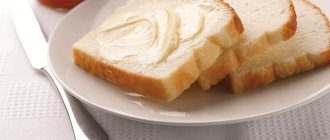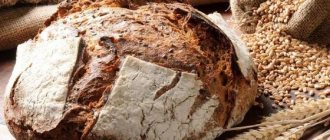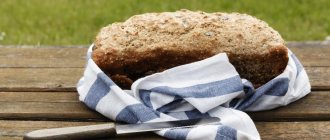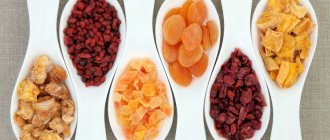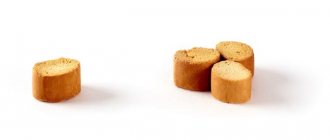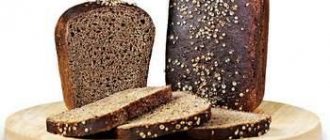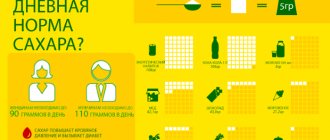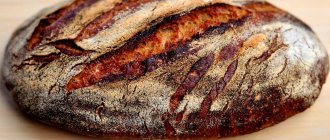Today, rye bread is loved all over the world. But it is unknown whether this product would exist in our time if it were not for the Russians. Indeed, in ancient times, in its homeland (which is southern Europe, Central and Asia Minor), rye was considered a weed. There this plant was carefully exterminated from fields sown with wheat and barley. And only closer to Northern and Central Europe did rye find true connoisseurs.
In the Middle Ages, it became one of the main crops grown in Rus', and rye bread became almost the main food product. And as modern researchers suggest, it was thanks to black bread that the Russians did not know what vitamin deficiency was.
What is rye bread
Rye bread is a type of baked goods made using special technologies from rye flour. This is exactly the bread that has been known since ancient times as “black”. No, rye flour is not black at all, although it is slightly darker than wheat. The raw dough made from it is almost no different from wheat, but under the influence of high temperature, rye baked goods darken.
The appearance of the loaf will tell you about the quality of rye bread. The crust of a properly prepared product has no cracks and does not peel off from the crumb. The inside of the loaf should be elastic, but not sticky, porous, but at the same time without voids. The shelf life of the rye product is from 24 to 36 hours.
Rye bread is considered an original Russian product. Back in the 11th-12th centuries. In Rus' they came up with a unique technology for making black bread without yeast using a special starter. And I must say, this technology is successfully used today.
Content:
- What is rye bread
- How to make black bread
- Product varieties
- What are the benefits of rye baked goods?
- Use in folk medicine
- Use in cosmetology
- Harm of rye bread
Without yeast
Recently, many girls who care about their health and figure have begun to consider yeast-free bread almost a panacea for all ills. This is a really useful product, but it still shouldn’t be idealized. Once upon a time, American nutritionist Howard Hay promoted the idea that it is generally dangerous for people to eat dishes with yeast - baked goods, kvass, beer, fermented milk products. He said that the gastric mucosa of modern man is damaged by antibiotics, drugs and stress, this has led to the spread of intractable fungal diseases, and yeast food only aggravates the situation. Hay's ideas have not found mass support among nutritionists, but there is some truth in them, so during the period of serious drug treatment (pneumonia, cystitis, bronchitis), it is better not to overuse regular bread. And after recovery, you can again safely switch to a yeast product.
How to make black bread
Rye flour differs from wheat flour not only in color, but also in chemical composition. The base for the black loaf does not contain gluten, without which it is very difficult to knead elastic dough. In addition, rye contains a lot of alpha-amylase. This substance promotes the conversion of starch into dextrin, which also does not have the best effect on the quality of baking dough.
Because of these features, rye flour products do not hold their shape well and “float”. But our ancestors, for whom rye grains were the basis of the diet, came up with a solution to the problem.
As already mentioned, the technology for producing rye bread was discovered back in the 11th century and has not changed much since then. In those distant times, cooks came up with the idea of using sourdough containing lactic acid bacteria. She took on the role of yeast: it causes fermentation and loosening of the dough. By the way, the taste and aroma of the finished product depends on the quality of the starter. In ancient times, sourdough recipes belonged to important family secrets and were passed down from generation to generation.
What types of bread are there?
You come to the store and see in front of you a variety of types and varieties of bread. With bran, cereal, with nuts, seeds, dried fruits, yeast-free and salt-free, wheat, fortified and rye. You first take one bread, begin to study its composition, then the second, third, etc. and catch yourself thinking that you don’t understand how they differ from each other.
At first glance, looking at the label, you might think that all bread has an almost identical composition: flour, water, salt, yeast and sourdough. The question is, what difference does it make then what kind of bread to take?
Rule!
To choose the right bread, you need to know that the quality and benefits of bread depend on the level of processing of cereals, namely the degree of flour grinding.
Product varieties
Not all rye bread is created equal. Back in the 17th century, 26 varieties of this product were known. Depending on the flour composition, it can be pure rye, rye-wheat and wheat-rye. By the way, bread made from a mixture of rye and wheat flour is known as gray. It is lighter than pure rye, but much darker than wheat. The gray version of bread is a kind of “golden mean”, which advantageously combines the advantages of two types of product.
According to production technology, rye baked goods can be unleavened, yeast-based or leavened. The first option involves kneading the dough without fermentation processes. Most commercially produced rye bread is made using yeast. But this option is considered the least useful. The kvass loaf is kneaded using a special sourdough starter.
In addition, baking can be simple or custard. In the second case, in addition to traditional ingredients, sugar, rye malt, molasses and spices are added to the dough. This bread is called custard for a reason. Before the main kneading, part of the flour and malt are brewed using boiling water. By the way, such loaves stay fresh longer.
The most famous rye custard bread is Borodinsky. The recipe for this sweet and spicy product was invented in the 19th century. In addition to rye flour, second-grade wheat flour, red rye malt, sourdough, salt, molasses, sugar, coriander, anise and cumin are used for its preparation.
Darnitsky bread is another equally popular variety of rye product. This recipe was invented in 1933 at Leningrad Bread. It is made from peeled rye flour, first grade wheat flour, liquid rye sourdough, salt and water. True, today most manufacturers replace traditional sourdough with compressed yeast.
Some housewives bake black bread at home. The complexity of the recipe lies in the long preparation of the sourdough. Before you start baking, you need to mix kefir, water and a little flour and leave the mixture for 7-10 days to ferment. During this time, you should regularly “feed” the starter by adding a little kefir and flour. But the finished base can be stored in the refrigerator for quite a long time.
Soft bread flatbread
Soft flatbread.
Photo: thinkstockphotos.com 1. Prepare the “liquid dough”: mix 2 cups (400 g) of wholemeal flour, 0.5 cups (100 g) of finely ground wheat flour, 50 g (2 tablespoons) of bran and 2.5 cups (600 ml) warm water in a bowl and leave for 10 minutes. Before use, add water or flour to the dough to bring the density to the consistency of liquid porridge. We do not add salt! 2. While the flour and cereal are soaked in moisture, heat a non-stick frying pan over high heat.
3. Using a spoon, place the dough in the center of the pan and distribute it throughout the pan with intense horizontal jerks. Fry the flatbread for 3-4 minutes on both sides. Place the finished flatbreads in a stack.
What are the benefits of rye baked goods?
Rye is an amazing cereal in its chemical composition. Flour from these grains is rich in fiber, proteins and amino acids, micro- and macroelements, vitamins, enzymes and mineral salts. The benefits of the product are further enhanced by the fact that whole grains, which are more saturated with nutrients, are often used to produce rye flour.
Many nutritionists call black bread one of the healthiest foods in the winter and spring diet. And only because, from a chemical point of view, it is incredibly rich in nutrients important for humans. To confirm this theory, many researchers cite examples from the past. Even in times of famine, when the diet was far from balanced, people who constantly consumed rye product did not suffer from vitamin deficiency. At the same time, rye baked goods, unlike wheat baked goods, are a low-calorie dietary product with a low glycemic index.
That is, sandwiches made from such bread will not stick to the sides as quickly as excess fat as products made from white flour.
The rich mineral and vitamin composition of this product has a beneficial effect on brain function and maintains muscle tone. It is considered beneficial for lowering cholesterol and preventing diabetes as it helps maintain healthy sugar levels in the bloodstream. By the way, it has been scientifically proven that women who eat rye bread instead of wheat bread are 3 times less at risk of diabetes. Rye bread also helps cleanse the body of toxins, salts and heavy metals.
Many lovers of black bread do not even suspect that it strengthens the nervous system. Each slice of the product contains a large amount of B vitamins that are beneficial for nerve cells. If you compare rye baked goods with wheat, the former contains several times more potassium and magnesium, as well as almost a third more iron. And this fact indicates that bread made from rye flour can prevent anemia.
Our ancestors obviously did not know this, but the rye product protected them from iodine deficiency. Only several centuries after the creation of the recipe for rye bread, researchers discovered rich reserves of iodine in its composition. This element is known to contribute to the proper functioning of the endocrine system and metabolism. Black loaf is also useful for digestive processes. As a rich source of fiber, it is important to include in your diet for people prone to constipation or obesity.
Rye bread is an amazing storehouse of substances with antioxidant properties. Vitamin E, selenium and chromium contained in the product are powerful natural protection against cancer and premature aging. In addition, this bread contains many polyunsaturated fatty acids from the omega-3 and omega-6 groups. And they (especially omega-3) are very beneficial for the cardiovascular system.
But still, the main advantages of the product are determined by natural leaven.
It, according to experts, helps remove carcinogenic compounds from the body. Lactic acid fermentation increases the bioavailability of micro- and macroelements contained in flour. In addition, lactic acid plays a special role for the proper functioning of the gastrointestinal tract; in particular, sourdough maintains healthy intestinal acidity. The correct acidity of the intestinal environment prevents the proliferation of pathogenic microflora and at the same time has probiotic properties, that is, it supports the viability of beneficial bacteria. Nutritional information per 100 g
| Calorie content | 259 kcal |
| Squirrels | 8.5 g |
| Fats | 3.3 g |
| Carbohydrates | 48.3 g |
| Vitamin B1 | 0.43 mg |
| Vitamin B2 | 0.34 mg |
| Vitamin B3 | 3.81 mg |
| Vitamin C | 0.4 mg |
| Sodium | 603 mg |
| Potassium | 166 mg |
| Calcium | 73 mg |
| Magnesium | 40 mg |
| Phosphorus | 125 mg |
| Iron | 2.83 mg |
Why do people get better from bread?
It’s worth clarifying right away that people get better not from any bread, but from the specific type of cereal that is used in its preparation. We are talking about wheat, the main disadvantage of which proponents of a healthy lifestyle call the presence of gluten.
This type of protein provokes a sharp increase in blood sugar, overloads the immune system, and does not allow micronutrients and minerals to be properly absorbed. It is called responsible for obesity, allergies, the development of heart disease and disruption of the gastrointestinal tract.
However, this was not always the case. Even at the beginning of the last century, wheat bread did not have so many shortcomings. The fact is that in the 50s of the 20th century, breeding scientists began to actively develop new types of wheat, with increased immunity to diseases, drought resistance, frost resistance and high growth rates.
Modern types meet all these requirements. However, one of the consequences of the crossings was a mutation of the protein - gluten, which in its current state is practically not digestible, since the human body simply does not have the necessary enzymes for this.
Important! Nutritionists have noticed that baked goods with the same calorie content have different effects on weight gain. Bread made from wheat flour promotes weight gain, while, for example, bread made from oatmeal has virtually no effect on overall weight. Over time, scientists have discovered that gluten disrupts the endocrine system, disrupting carbohydrate-cholesterol metabolism and inhibiting the recovery of liver cells.
The second reason that leads to excess weight gain when eating bread is additional products. Often bread is not eaten in its pure form, but as a basis for sandwiches, generously using high-calorie sauces, various types of butter, sausages and fatty cheeses.
This combination of products is a real blow to the figure, provoking not only an increase in adipose tissue, but also the production of large amounts of insulin, which is responsible for the feeling of hunger. The result is that even despite a very high-calorie snack, a person does not feel full. Moreover, after a short time he will feel hungry again.
The third reason why bread makes you fat is the amount of it. According to nutritionists, the optimal daily intake of bread is 120-150 grams. This means that you can eat no more than 4-5 medium-sized pieces per day.
Be sure to check out:
Use in folk medicine
In Rus', rye pastries were consumed not only as a staple food, but also as medicine. Our ancestors used black loaf to treat stomach upsets, coughs, sore throats, skin problems, headaches and even insomnia.
For diarrhea, for example, they drank a water infusion made from bread. To do this, 1-2 slices of the product were poured with half a liter of cold water and left for several hours in the cold. Then the strained liquid was consumed in half a glass every hour.
To get rid of headaches, traditional healers advised applying pieces of black loaf soaked in plantain juice to the temples for 15 minutes.
Ordinary rye bread, sprinkled with salt and chopped garlic, was used as an anthelmintic. The same drug was considered one of the most effective for treating colds or flu. A severe cough was once treated with “mustard plasters” made from slices of rye pastry. To do this, sprinkle a tablespoon of mustard on a thick piece of stale product and pour boiling water over it. Then a slice of bread was taken out of the water, wrapped in gauze and applied to the chest or back like a mustard plaster. Something similar was used to treat sore throat. The bread was also poured with boiling water, but without mustard. The soaked pulp was tied to the neck overnight. And to treat a runny nose, it was advised to inhale the smoke of burnt rye bread.
In Rus', black bread was also used to get rid of boils. A piece of the product was thoroughly chewed and then applied to the boil. By the way, black loaf is also useful for treating acne. If you pour hot water over the pulp, then squeeze it out and mix it with honey, you get a medicinal paste against acne.
It is useful to apply this mixture to problem areas twice a week and keep it as a mask for 15-20 minutes.
Expert opinion
Valery Sergeev, Candidate of Medical Sciences, nutritionist and gastroenterologist at the Telos beauty clinic:
– Don’t give up whole grain bread! Even for those men and women who are on a fasting diet, we recommend 50 g of product per day. Only people suffering from celiac disease, a hereditary intolerance to the plant protein gluten, should not eat bread. But even today a special anti-gluten product and a variety of breads are sold for them.
Use in cosmetology
Beauty recipes using rye bread were known back in Rus'. Some of them, in parallel with modern cosmetics, are still used today.
Dried slices of rye product can serve as an excellent base for a scrub. Bread crumbs can be mixed with a small amount of salt and avocado oil, massaged onto a steamed face and rinsed off.
If you pour a slice of bread with hot milk, and then add grated horseradish, honey and a little cottage cheese to the mixture, you will get the basis for a whitening mask. To moisturize the skin, they used to use a paste of bread doused with hot nettle infusion. To smooth out facial wrinkles, you can use a mask made from black bread crumbs, sour cream and rose essential oil. A cosmetic gruel made from rye product, algae and yolk will help restore skin elasticity.
Rye bread can be good for hair. To speed up their growth, use water in which slices of bread were soaked for 2 hours. The liquid should be rubbed into the roots of the hair, wrapped in plastic and a towel, and washed off after an hour. Instead of ordinary water, you can use a decoction of herbs for the infusion (nettle, mint, chamomile, yarrow, linden, calendula and others are suitable), and you can add a little honey and castor oil to the finished infusion.
Best materials of the month
- Coronaviruses: SARS-CoV-2 (COVID-19)
- Antibiotics for the prevention and treatment of COVID-19: how effective are they?
- The most common "office" diseases
- Does vodka kill coronavirus?
- How to stay alive on our roads?
However, these are only examples of possible homemade cosmetics using rye bread. You can take the ingredients that work best for you.
Bread causes intestinal inflammation
Where did this idea come from? Bread is made from grain, and grain contains gluten, which causes intestinal inflammation - celiac disease.
Like really. What is true is true - grains do indeed contain gluten, the consumption of products with which actually provokes celiac disease in people predisposed to this. But there are very few such people. For you to get celiac disease, you must have two rare genes in your genome. But even if they exist, it is not a fact that you will still get sick - of all carriers of the “unsuccessful” genetic set, less than one percent of people get sick. For all other people, there is no point in being afraid of intestinal inflammation - no matter how much bread you eat, without the “necessary” genes, celiac disease will still not happen.
Harm of rye bread
Even such a healthy product as rye bread has contraindications. In particular, due to its high acidity, this product is contraindicated for people with digestive ulcers, colic, gastritis or heartburn, and liver or gallbladder diseases.
If you replace wheat bread with rye bread in a traditional diet, you can reduce the risk of coronary heart disease several times. This assumption was made by American scientists. It is difficult to say whether this is actually true, but the fact that since ancient times black bread was considered good for health is an indisputable fact.
More fresh and relevant information about health on our Telegram channel. Subscribe: https://t.me/foodandhealthru
We will be grateful if you use the buttons:
Bread: to eat or not to eat?
Snow-white loaves, baguettes, ciabattas, rolls, flatbreads, loaves, croissants, cheesecakes, doughnuts, cookies, crumpets, puff pastries, braids, pies, dumplings, muffins, cakes, pastries, bagels, bagels, croutons, straws, crispbread, biscuits, crackers , waffles, gingerbread...
Flour products in European culture exist in such variety and are so tasty that they can break even the most resilient psyche. And even more so for the unstable child’s psyche. If we had not developed a strong psychological attachment to bread and flour products from preschool age, then everything would be fine!
